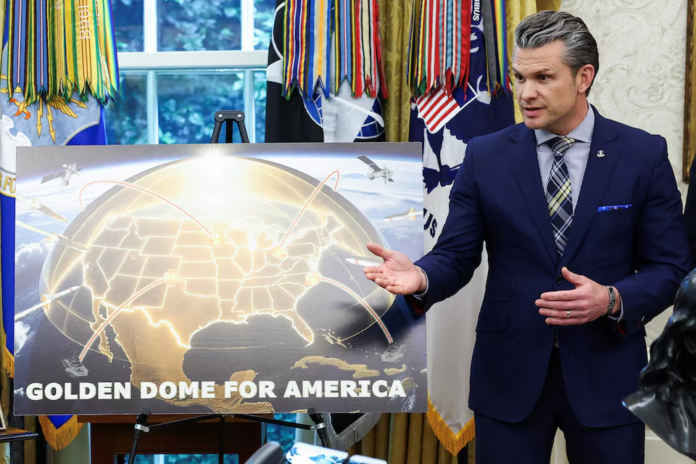U.S. President Donald Trump on Tuesday announced the selection of a design for the $175 billion Golden Dome missile defence shield and named U.S. Space Force General Michael Guetlein as the program’s lead manager.
The ambitious initiative, first ordered by Trump in January, aims to build a vast network of satellites, potentially numbering in the hundreds, to detect, track, and intercept incoming missile threats from adversaries such as China and Russia.
Speaking at a White House press conference, Trump said the system would “protect our homeland” and noted that Canada expressed interest in joining the project. The Canadian Prime Minister’s office confirmed ongoing discussions with U.S. counterparts about enhancing security ties, including strengthening NORAD and related initiatives like Golden Dome.
The defence shield is slated for completion by January 2029, the end of Trump’s presidential term, but experts have expressed skepticism about both the timeline and cost. The Congressional Budget Office estimates the program could cost as much as $831 billion over 20 years.
“Ronald Reagan wanted it many years ago, but they didn’t have the technology,” Trump said, referencing the space-based missile defence system popularly known as “Star Wars,” proposed in the 1980s.
The Golden Dome program faces political scrutiny and funding uncertainty. Republican lawmakers have proposed a $25 billion initial investment within a broader $150 billion defence package, though this funding depends on the passage of a contentious reconciliation bill facing congressional hurdles.
“Unless reconciliation passes, the funds for Golden Dome may not materialize,” said an industry executive who asked to remain anonymous, warning the project timeline is at risk.
The program is expected to leverage Silicon Valley’s software expertise alongside existing missile defence technologies. Trump ally Elon Musk’s SpaceX has emerged as a frontrunner to build key components, alongside companies like Palantir and Anduril.
Senator Kevin Cramer (R-N.D.) described the initiative as a “new autonomous space-age defence ecosystem” driven more by Silicon Valley innovation than traditional “big metal” defence contractors.
The Golden Dome concept draws inspiration from Israel’s land-based Iron Dome missile defence system but expands it dramatically to include a massive satellite array capable of offensive missile interception soon after launch.
Trump highlighted that Alaska, Florida, Georgia, and Indiana would benefit from the program. Early production is expected to come from existing defence manufacturing lines, with L3Harris Technologies, Lockheed Martin, and RTX Corp named as potential contractors.
L3Harris recently invested $150 million in a facility in Fort Wayne, Indiana, producing satellites that track hypersonic weapons, which could be adapted for Golden Dome.
Tuesday’s announcement launches Pentagon efforts to test and procure the missiles, sensors, satellites, and systems required to build the shield.























